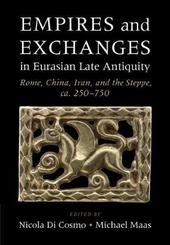
|
Empires and Exchanges in Eurasian Late Antiquity: Rome, China, Iran, and the Steppe, ca. 250-750
Hardback
Main Details
| Title |
Empires and Exchanges in Eurasian Late Antiquity: Rome, China, Iran, and the Steppe, ca. 250-750
|
| Authors and Contributors |
Edited by Nicola Di Cosmo
|
|
Edited by Michael Maas
|
| Physical Properties |
| Format:Hardback | | Pages:538 | | Dimensions(mm): Height 262,Width 185 |
|
| Category/Genre | Asian and Middle Eastern history |
|---|
| ISBN/Barcode |
9781107094345
|
| Classifications | Dewey:930.5 |
|---|
| Audience | | Professional & Vocational | | General | |
|---|
| Illustrations |
9 Maps; 35 Halftones, black and white; 4 Line drawings, black and white
|
|
Publishing Details |
| Publisher |
Cambridge University Press
|
| Imprint |
Cambridge University Press
|
| Publication Date |
26 April 2018 |
| Publication Country |
United Kingdom
|
Description
Empires and Exchanges in Eurasian Late Antiquity offers an integrated picture of Rome, China, Iran, and the Steppes during a formative period of world history. In the half millennium between 250 and 750 CE, settled empires underwent deep structural changes, while various nomadic peoples of the steppes (Huns, Avars, Turks, and others) experienced significant interactions and movements that changed their societies, cultures, and economies. This was a transformational era, a time when Roman, Persian, and Chinese monarchs were mutually aware of court practices, and when Christians and Buddhists criss-crossed the Eurasian lands together with merchants and armies. It was a time of greater circulation of ideas as well as material goods. This volume provides a conceptual frame for locating these developments in the same space and time. Without arguing for uniformity, it illuminates the interconnections and networks that tied countless local cultural expressions to far-reaching inter-regional ones.
Author Biography
Nicola Di Cosmo is the Henry Luce Foundation Professor of East Asian History at the Institute for Advanced Study, Princeton, New Jersey. He has held positions at the University of Cambridge, Harvard University, and Canterbury University in New Zealand. His publications include Ancient China and Its Enemies: The Rise of Nomadic Power in East Asian History (Cambridge, 2002), Manchu-Mongol Relations on the Eve of the Quing Conquest (2003), The Cambridge History of Inner Asia: The Chinggisid Age (Cambridge, 2009), Warfare in Inner Asian History (500-1800) (2002), and Military Culture in Imperial China (2011). Michael Maas is the William Gaines Twyman Professor of History at Rice University, Houston, where he also directs the Program in Ancient Mediterranean Civilizations. A former Director in Byzantine Studies at Dumbarton Oaks, he has published widely in late antique history, including Exegesis and Empire in the Early Byzantine Mediterranean. Junillus Africanus and the Instituta Regularia Divinae Legis (2003) and The Cambridge Companion to the Age of Attila (Cambridge, 2014).
Reviews'It is difficult in a brief review to do justice to such a rich variety of contributions, but enough has been said to give a flavor of the riches before us. This is an inspiring book. It establishes Eurasian Late Antiquity as a cohesive area of study at the same time as it demonstrates the sheer excitement of the subject. The editors have done us a great service in bringing together such a thought provoking volume.' Barry Cunliffe, Asian Perspectives '... Di Cosmo and Maas' volume makes a convincing case for historians and archaeologists to take a Eurasian perspective when studying their particular regions or sites.' Arezou Azad, Medieval Archaeology
|